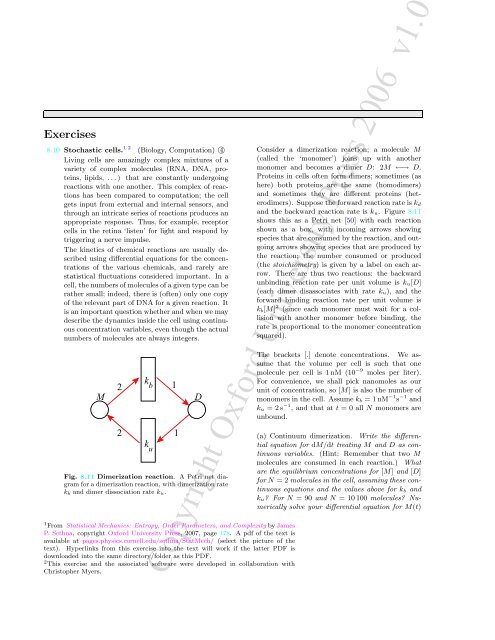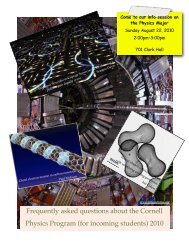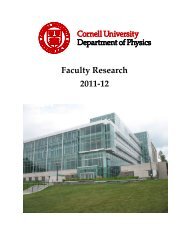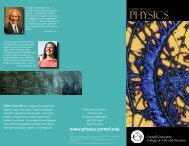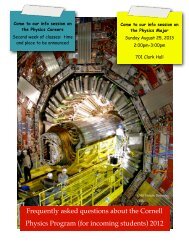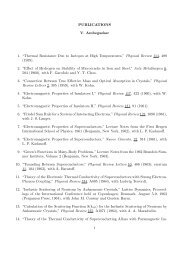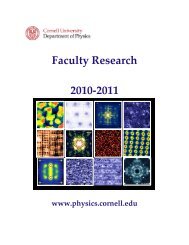Stochastic Cells Exercise - Physics
Stochastic Cells Exercise - Physics
Stochastic Cells Exercise - Physics
Create successful ePaper yourself
Turn your PDF publications into a flip-book with our unique Google optimized e-Paper software.
<strong>Exercise</strong>s<br />
8.10 <strong>Stochastic</strong> cells. 1 2 (Biology, Computation) ○4<br />
Living cells are amazingly complex mixtures of a<br />
variety of complex molecules (RNA, DNA, proteins,<br />
lipids, . . . ) that are constantly undergoing<br />
reactions with one another. This complex of reactions<br />
has been compared to computation; the cell<br />
gets input from external and internal sensors, and<br />
through an intricate series of reactions produces an<br />
appropriate response. Thus, for example, receptor<br />
cells in the retina ‘listen’ for light and respond by<br />
triggering a nerve impulse.<br />
The kinetics of chemical reactions are usually described<br />
using differential equations for the concentrations<br />
of the various chemicals, and rarely are<br />
statistical fluctuations considered important. In a<br />
cell, the numbers of molecules of a given type can be<br />
rather small; indeed, there is (often) only one copy<br />
of the relevant part of DNA for a given reaction. It<br />
is an important question whether and when we may<br />
describe the dynamics inside the cell using continuous<br />
concentration variables, even though the actual<br />
numbers of molecules are always integers.<br />
M<br />
2<br />
k<br />
b<br />
2 1<br />
k<br />
Fig. 8.11 Dimerization reaction. A Petri net diagram<br />
for a dimerization reaction, with dimerization rate<br />
k b and dimer dissociation rate k u.<br />
u<br />
1 From Statistical Mechanics: Entropy, Order Parameters, and Complexity by James<br />
P. Sethna, copyright Oxford University Press, 2007, page 178. A pdf of the text is<br />
available at pages.physics.cornell.edu/sethna/StatMech/ (select the picture of the<br />
text). Hyperlinks from this exercise into the text will work if the latter PDF is<br />
downloaded into the same directory/folder as this PDF.<br />
2 This exercise and the associated software were developed in collaboration with<br />
Christopher Myers.<br />
1<br />
D<br />
Consider a dimerization reaction; a molecule M<br />
(called the ‘monomer’) joins up with another<br />
monomer and becomes a dimer D: 2M ←→ D.<br />
Proteins in cells often form dimers; sometimes (as<br />
here) both proteins are the same (homodimers)<br />
and sometimes they are different proteins (heterodimers).<br />
Suppose the forward reaction rate is k d<br />
and the backward reaction rate is k u. Figure 8.11<br />
shows this as a Petri net [50] with each reaction<br />
shown as a box, with incoming arrows showing<br />
species that are consumed by the reaction, and outgoing<br />
arrows showing species that are produced by<br />
the reaction; the number consumed or produced<br />
(the stoichiometry) is given by a label on each arrow.<br />
There are thus two reactions: the backward<br />
unbinding reaction rate per unit volume is k u[D]<br />
(each dimer disassociates with rate k u), and the<br />
forward binding reaction rate per unit volume is<br />
k b [M] 2 (since each monomer must wait for a collision<br />
with another monomer before binding, the<br />
rate is proportional to the monomer concentration<br />
squared).<br />
The brackets [.] denote concentrations. We assume<br />
that the volume per cell is such that one<br />
molecule per cell is 1 nM (10 −9 moles per liter).<br />
For convenience, we shall pick nanomoles as our<br />
unit of concentration, so [M] is also the number of<br />
monomers in the cell. Assume k b = 1 nM −1 s −1 and<br />
k u = 2 s −1 , and that at t = 0 all N monomers are<br />
unbound.<br />
(a) Continuum dimerization. Write the differential<br />
equation for dM/dt treating M and D as continuous<br />
variables. (Hint: Remember that two M<br />
molecules are consumed in each reaction.) What<br />
are the equilibrium concentrations for [M] and [D]<br />
for N = 2 molecules in the cell, assuming these continuous<br />
equations and the values above for k b and<br />
k u For N = 90 and N = 10 100 molecules Numerically<br />
solve your differential equation for M(t)<br />
Copyright Oxford University Press 2006 v1.0
2<br />
for N = 2 and N = 90, and verify that your solution<br />
settles down to the equilibrium values you<br />
found.<br />
For large numbers of molecules in the cell, we expect<br />
that the continuum equations may work well,<br />
but for just a few molecules there surely will be relatively<br />
large fluctuations. These fluctuations are<br />
called shot noise, named in early studies of electrical<br />
noise at low currents due to individual electrons<br />
in a resistor. We can implement a Monte<br />
Carlo algorithm to simulate this shot noise. 3 Suppose<br />
the reactions have rates Γ i, with total rate<br />
Γ tot = ∑ i<br />
Γi. The idea is that the expected time<br />
to the next reaction is 1/Γ tot, and the probability<br />
that the next reaction will be j is Γ j/Γ tot. To simulate<br />
until a final time t f , the algorithm runs as<br />
follows.<br />
(1) Calculate a list of the rates of all reactions in<br />
the system.<br />
(2) Find the total rate Γ tot.<br />
(3) Pick a random time t wait with probability distribution<br />
ρ(t) = Γ tot exp(−Γ tot t).<br />
(4) If the current time t plus t wait is bigger than<br />
t f , no further reactions will take place; return.<br />
(5) Otherwise,<br />
– increment t by t wait,<br />
– pick a random number r uniformly distributed<br />
in the range [0, Γ tot),<br />
– pick the reaction j for which ∑ i


